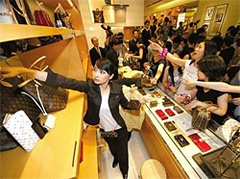At first glance, the rise of China's luxury goods business seems to defy logic. On the one hand, the country's per capita GDP is ranked 94th in the world — behind countries like Jamaica and Bosnia; on the other, it is expected to soon overtake Japan and the U.S. as the world’s largest luxury market. The quick and easy explanation for the paradox is that standards of living and income levels are rising along with China's economy, producing a growing number of millionaires and billionaires. But there's more to what's fuelling China's US$12 billion luxury goods sector than simply having the means to consume. As with other discretionary purchases, retail experts say buying designer clothes, jewellery and other high-end goods in China is also driven by emotions, culture, social values and a certain amount of political baggage.
China's consumer culture has been molded by a “melting pot” of values, according to Pierre Xiao Lu, a professor at Shanghai’s Fudan University, who specializes in luxury marketing research. That includes strong values revolving around modernity, wealth and success, many of which were shaped during post-reform socialism some 30 years ago under Chairman Deng Xiaoping, who famously said, "Let some people get rich first."
"Suddenly, the country’s flat socialist structure opened up vertically," say Lu. "Distinguishing oneself from others by Western-style success, wealth and modernity became desired and admired. The dominant narrative of modern China became that of upward mobility – both for the nation and the Chinese individual.”
The pursuit of luxury chimes with this narrative. “It’s the most efficient way to measure success,” says Jeffrey Wong, CEO of Meici.com, a Shanghai-based online luxury boutique. As a huge, densely populated country, China is a "very competitive society," he observes. "At the same time, social recognition is one of the fundamental needs of human nature." How can people stand out in this highly competitive environment?" By consuming luxury goods, says Wong, who draws comparisons to China today with Europe's industrializing, increasingly capitalistic society of a century ago.
High-Class Act
What differentiates China from other countries is the flattening of its traditional social classes during the communist revolution. “Compared with other societies that are more class-based, [China's] relatively flat social structure and the fact that all money is 'new money' put everyone on a equal footing in their endeavour to succeed,” says Ashok Sethi, Shanghai-based head of consumer insight of TNS,a market research company.
The absence of class also means there is — in Sethi's words — "no 'inverted snobbery' or 'old money' looking down on the ostentatious … 'new rich,' which discourages luxury products, and in fact makes it fashionable to appear casual and use moderately priced products," he says. "This is a sentiment restricting the luxury goods market in developed countries, but it does not appear to be making a strong dent in China.”
But there's another twist in China. According to a report published earlier this year by McKinsey, the "middle class aspirant" is a rapidly growing segment of luxury goods consumers in China. Predominantly lower middle class, this group must save up money in order to afford luxury products, which are prohibitively expensive relative to their incomes. Although their purchases are infrequent and account for only 10% of the total value of luxury purchases, they are 51% of the luxury customer base. By 2015, 61% of all luxury customers will be middle class aspirants, accounting for 16% of the country's US$27 billion of luxury sales.
Social aspirers are greatly influenced by wealthier, more fashionable consumers, whose numbers are multiplying. By 2015, there will be 76 million upper middle class households, compared with 13 million today, with annual incomes of between RMB 100,000 and RMB 200,000 (US$15,400 and US$30,800), says McKinsey consultants. The number of wealthy households earning between RMB 300,000 and RMB 1 million annually will increase 15% annually to 5.6 million and those above RMB 1 million will increase 20% annually to one million over the coming years.
It's the young middle class aspirants in China that are the ones to watch, says Vinay Dixit, senior director of McKinsey’s Asia Consumer Centers. “They have grown up in a consumerist society, they are optimistic about their future income rising, and they were born under the single-child policy," she says. "Their purchases may be supported by their parents and grandparents, so you have three generations pooling resources. This is quite unique to China.”
Old or young, Dixit notes that although the country's per capita savings rate is relatively high compared with that of other countries, increasing optimism and hedonism are influencing middle class consumers willing to spend on luxury. “There is the sense of ‘I need to reward myself for hard work now, not in 30 years,’” Dixit adds.
Luxury goods retailers have now woken up to the buying power of the aspirants, who predominantly live in smaller tier two and three cities. Consultants at Bain & Company say that in 2010, around 67% of luxury sales growth in China came from new customers, particularly in lower tier cities. That undoubtedly is making a significant impact on retailers' growth strategies. “China's market is supply-driven; new store openings create new demand,” the report says. The 15 brands it surveyed opened a total of around 80 stores in the first eight months of 2010.
Analysts expect this trend to continue. McKinsey estimates that residents of around 20 to 30 lower tier cities are about to break through to higher income levels, leading to a growing number of aspiring luxury consumers.
It's Not Who You Wear…
Such trends are leading some observers to voice concern that too many Chinese are using luxury goods as a crude social tool of judging the strength of a person's character, as opposed to focusing on noble, less materialistic qualities. Though in the luxury business, Wong of Meici says, “When people judge their peers by what they wear, society risks becoming too materialistic. However, this is a trend that businesspeople can take advantage of today."
During a recent luxury business conference in Shanghai hosted by China European International Business School, Bruno Lannes, a partner at private equity firm Bain Capital, observed, “Luxury is always connected with history, tradition, arts, culture and craftsmanship. It’s also related to exclusivity and uniqueness; it’s about quality and service. The problem right now in China is that many people aren't buying luxury goods for those reasons." Rather, they see luxury goods as a proxy for their identity, "which is a misunderstanding of luxury,” he said.
Along with the link to social identity, Fudan University's Lu observes that many Chinese see luxury goods consumption as part of their search for identity and power in a modern world dominated by the West. “As the West represents advanced technology, super powers and modern values, the majority of mainland Chinese seek to pursue these values the best they can," he adds.
This is particularly acute among the older generation, who grew up during the Cultural Revolution. Known as the "lost generation," they missed out on higher education and lived in a cultural void that aimed to obliterate Chinese history. Now, say experts, they are often responsible for some of the country's most crass imitations of Western style and power. That includes a faux Chateau de Maisons-Laffitte in a Beijing suburb and a replica of the White House in rural Anhui province.
“Now in their 50s, some of the lost generation have attained new wealth," Lu says. "They can [afford to] purchase luxury goods, but often lack subtlety. They are ostentatious and have a skewed view of what is traditional or socially acceptable, which explains their very extravagant behavior.”
What's disconcerting for some consumers, however, is the lack of Chinese luxury brands. According to Bain, all the top-selling high-end fashion labels in China are Western European, such as Chanel, Gucci and Louis Vuitton. Yet luxury consumption in general is far from new in China, says Lu, citing the country's love of high-end antiques, which dates back hundreds of years. "Is there no Chinese brand capable of providing the essence of the luxury found in ancient Chinese culture?” Lu asks.
A recent report on China’s luxury market by brokerage house CLSA predicts that home-grown luxury brands will emerge eventually, particularly for goods based on domestic materials like jade, porcelain and precious wood. The report notes that items not considered luxury items elsewhere, such as 80-year-old Puer tea or Hainan redwood furniture, are already being sold at record prices in China.
In response, international brands are localizing products for their Chinese customers. In a McKinsey survey of more than 1,500 luxury consumers in 17 cities in China last year, one-third of the respondents said they prefer to buy luxury products designed specifically for China. “Among young and upper middle class consumers, in particular, the desire for luxury products that draw on China's rich cultural and historical heritage is evident — and some companies are responding." For example, last year, French fashion house Hermes launched the first of what it plans to be several Shang Xia stores in Shanghai to sell its ready-to-wear collection based on Chinese designs and craftsmanship.
Complex and Contradictory
Using psychological segmentation, Lu's research has identified an important group of luxury consumers who want to be both conspicuous and conservative or understated. The Chinese tradition celebrating a person's ability to be discreet and frugal was underpinned by pre-reform socialism, which prohibited and even punished displays of individuality and wealth. Today, however, older values sit awkwardly alongside newer, post-reform and Western values embracing displays of financial success and achievement.
The contradicting values are particularly evident among consumers working in the public sector. Lu's research found that government officials who can afford luxury goods are more understated than their counterparts in the business world. “In [a public sector] setting, wealth should not be overtly expressed or shown off to others," he says. "Products with discreet designs, such as ties, scarves, business suits or handbags without logos, are the most popular.”
As in developed markets, conspicuous consumption is likely to fade as its novelty wears off among China's consumers. McKinsey found that Chinese consumers with longer exposure to luxury consumption now like less conspicuous brands, while quality and price-value relationships play a greater role in purchasing decisions. “There’s a large shift in loyalties going on," says Dixit. "The way that brands establish themselves in the next five years will have a disproportionate effect in the long run.”



